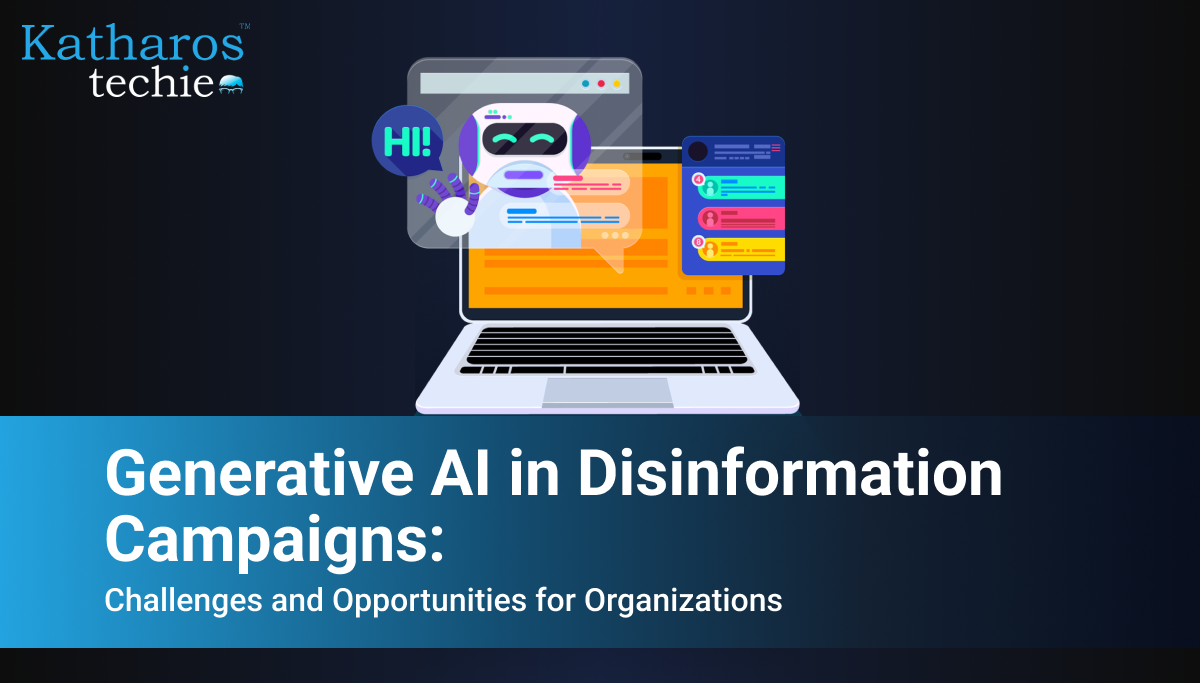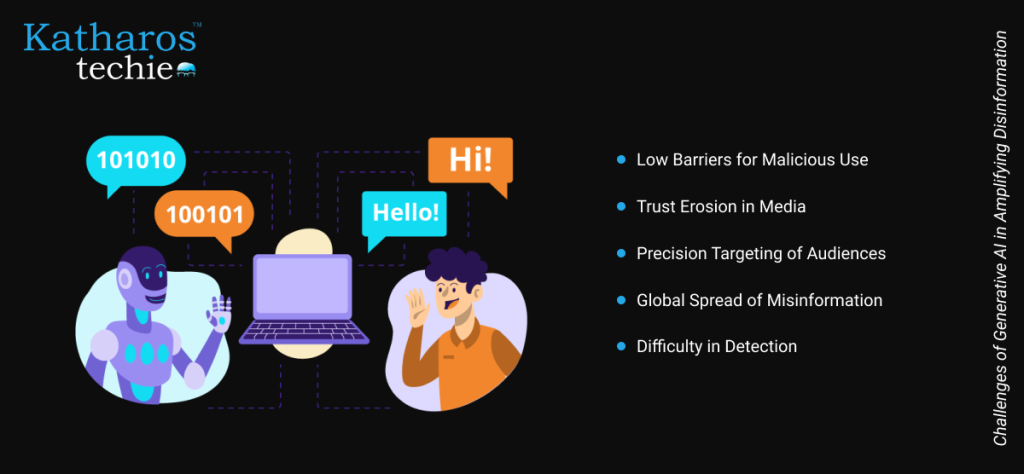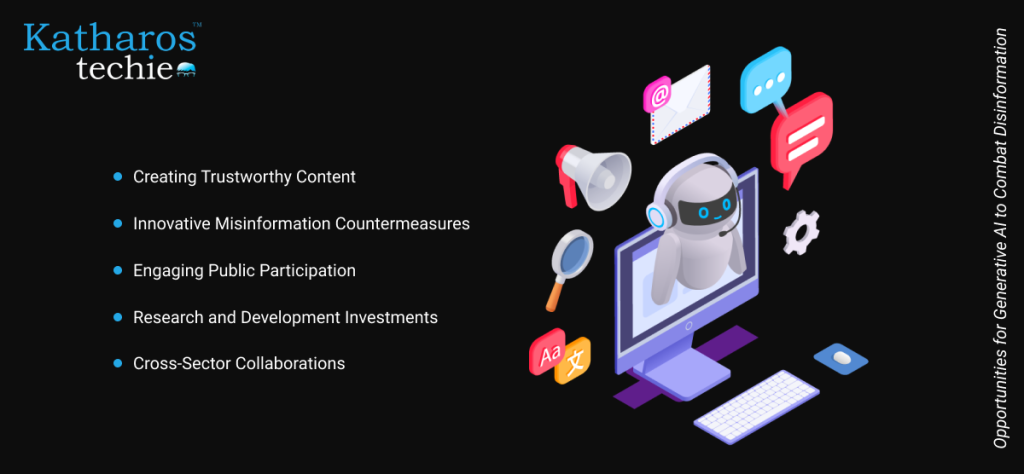
Generative AI in Disinformation Campaigns
By Ankita Das

Generative AI is transforming how information is created and disseminated, offering unprecedented opportunities for innovation. However, this technology also poses significant risks, especially in disinformation campaigns. Generative AI in Disinformation Campaigns enables the mass production of realistic fake content to manipulate public opinion, eroding trust in reliable information and disrupting democratic processes. The accessibility and affordability of generative AI further lower the barriers to misuse, negatively impacting global information ecosystems.
This blog delves into the challenges posed by generative AI in disinformation campaigns and explores actionable solutions that organizations can adopt to safeguard against these threats. Scroll down to discover how to achieve this while using the technology responsibly.
Understanding Disinformation Amplified by Generative AI
Generative AI enables the rapid production of text, images, and videos that can easily deceive audiences. The emotional appeal of AI-generated disinformation often resonates deeply with viewers, making it more persuasive and impactful. Enhanced realism in these creations blurs the line between genuine and fabricated content, leading to widespread misinformation.
For instance, political ads have increasingly utilized generative AI to craft misleading narratives that manipulate public perception. These ads often present distorted facts or fabricate events to divert voter opinions during elections. Similarly, fake news articles generated by AI can spread rapidly across social media platforms, further amplifying their reach and influence.
Another notable example is deepfake technology, which creates hyper-realistic videos that can depict individuals saying or doing things they never did. Such videos have been used in various disinformation campaigns, undermining trust in media and public figures.
Moreover, generative AI can produce fake reviews and testimonials that artificially inflate the credibility of products or services online. This manipulation not only misleads consumers but also disrupts fair competition in the market. As generative AI continues to evolve, its potential for misuse in disinformation campaigns poses significant challenges for organizations and society. Addressing these issues is crucial to maintaining trust and integrity in information dissemination.
Challenges of Generative AI in Disinformation Campaigns

Generative AI introduces significant challenges in combating disinformation due to its accessibility, scalability, and ability to manipulate information effectively. The technology enables malicious users to create convincing fake content, undermining trust and spreading misinformation globally. Listed below are some challenges of disinformation amplified by GenAI.
1. Low Barriers for Malicious Use
Generative AI tools are widely accessible, allowing even unskilled users to produce high-quality disinformation effortlessly. The affordability of these technologies further lowers the cost of running disinformation campaigns, incentivizing malicious actors to exploit them. This democratization of disinformation creation poses a major challenge for regulators and organizations.
2. Trust Erosion in Media
AI-generated disinformation undermines trust in reliable information sources, creating skepticism about all online information. The “liar’s dividend” phenomenon makes people doubt verified facts during crises or conflicts. This erosion of trust destabilizes public discourse and weakens democratic institutions.
3. Precision Targeting of Audiences
Generative AI enables highly targeted disinformation campaigns by analyzing user data and tailoring content to specific demographics. These precision-targeted efforts manipulate opinions effectively, influencing elections, public debates, and consumer behavior.
4. Global Spread of Misinformation
The scalability of generative AI allows disinformation to spread rapidly across borders, complicating regulation and enforcement. Governments and political actors use AI-generated propaganda to manipulate global narratives and suppress dissent.
5. Difficulty in Detection
AI-generated content is often indistinguishable from authentic material, making it challenging to detect fake information. As generative AI tools grow more sophisticated, traditional detection methods become increasingly ineffective. Organizations struggle to identify and counteract these threats promptly.
While the challenges posed by generative AI in amplifying disinformation are significant, they are not insurmountable. Organizations can adopt several innovative strategies to counteract these threats. The following section explores actionable solutions that can empower organizations to combat disinformation effectively.
Effective Solutions for Organizations Against Disinformation

Organizations must adopt a proactive approach to combat the challenges posed by generative AI in disinformation campaigns. Implementing effective strategies can help mitigate risks and safeguard the integrity of information. Here are several key solutions organizations can consider.
1. AI Detection Tools Development
Developing advanced AI detection tools is essential for identifying and flagging disinformation quickly. These tools can analyze content patterns and recognize anomalies, helping organizations filter out fake information efficiently. Continuous improvement of these tools is crucial to staying ahead of evolving disinformation tactics.
2. Regulatory Frameworks Implementation
Implementing regulatory frameworks can establish guidelines for the ethical use of generative AI technologies. Governments and organizations should collaborate to create policies that hold malicious actors accountable for spreading disinformation. Clear regulations can deter misuse and promote responsible AI development.
3. Employee Training Programs
Training employees to recognize and respond to disinformation threats is vital for organizational resilience. Regular workshops and seminars can equip staff with the skills to identify fake content. Empowered employees can act as frontline defenders against misinformation within their organizations.
4. Public Awareness Campaigns
Launching public awareness campaigns can educate individuals about the risks of disinformation. Such initiatives can promote media literacy, helping the public discern authentic information from fake content. Increased awareness fosters a more informed citizenry capable of resisting manipulation.
5. Collaboration with Tech Firms
Collaborating with technology companies can enhance the effectiveness of disinformation countermeasures. Partnerships can lead to innovative solutions that improve transparency and accountability in AI-generated content. Joint efforts can create a more robust defense against misinformation.
Implementing solutions to combat disinformation is a critical step, but generative AI also presents unique opportunities to fight back against misinformation. By using the same technology responsibly, organizations can create tools and strategies to promote accuracy and trust in information.
Opportunities for Generative AI to Combat Disinformation Campaigns

While generative AI poses significant challenges in disinformation, it also presents unique opportunities to counteract these threats. By leveraging their capabilities, organizations can develop innovative solutions to promote accuracy and trust in information dissemination. Here are several key opportunities for utilizing generative AI effectively.
1. Creating Trustworthy Content
Generative AI can be harnessed to produce accurate and reliable content at scale. Organizations can use AI to generate informative articles, reports, and educational materials that counter disinformation. By fostering openness and reliability, they can rebuild public trust in information sources.
2. Innovative Misinformation Countermeasures
AI technology can be employed to develop sophisticated misinformation countermeasures. For example, organizations can create tools that automatically flag or debunk false claims in real time. These countermeasures can significantly reduce the spread of disinformation across digital platforms.
3. Engaging Public Participation
Generative AI can facilitate public participation in identifying and reporting disinformation. Platforms can encourage users to flag suspicious content, fostering a community-driven approach to combat misinformation. Engaging the public empowers individuals to take an active role in maintaining information integrity.
4. Research and Development Investments
Investing in research and development can lead to breakthroughs in understanding and combating disinformation. Rewrite for clarity: Organizations should prioritize funding studies exploring misinformation dynamics and effective counter-strategies. These investments can yield valuable insights for future initiatives.
5. Cross-Sector Collaborations
Collaborating across sectors can enhance collective efforts against disinformation. Partnerships between governments, tech companies, and civil society organizations can create comprehensive strategies. By combining their expertise, stakeholders can unite against misinformation.
Generative AI represents a transformative technology with immense potential, but its misuse in disinformation campaigns poses serious challenges for organizations. Organizations can adopt innovative solutions, such as AI detection tools, regulatory frameworks, and public awareness campaigns, to combat these threats effectively. Furthermore, generative AI offers opportunities to counter disinformation by creating trustworthy content, developing advanced countermeasures, and fostering collaborations across sectors. So, what are you waiting for? Partner with Katharos Techie today and take the first step towards securing your digital integrity.